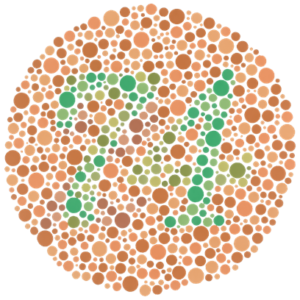Taking your colour vision for granted
Think about how many times a day we rely on our colour vision. You’re driving to work and you can see when the traffic light turns from red to green, or perhaps you’re cooking chicken for dinner and check inside to see if it’s cooked through. Maybe you’re choosing your outfit for the day and just take for granted that you know which shades do and don’t clash, or you’re separating your clothes for different coloured washes. There are so many situations in our day to day lives where our colour vision is essential and occasionally, such as with traffic light signals, our lives even depend on it. Now imagine you lack the ability to differentiate between certain hues. This is a reality for the 1 in 12 men and 1 in 200 women who are colour blind, reducing their colour vision range from millions of shades down to just 10,000 colours.
How does colour blindness occur?
Colour blindness, also known as colour deficiency, is a condition preventing someone from distinguishing between particular colours – most commonly reds and greens. It might also cause you to see the colours as duller than they actually appear. To understand how and why colour blindness occurs in an individual, it’s important to understand the structure of the eye – namely the retina – and how colour is processed by the eye. The retina is at the back of the eye and is the part responsible for forming images from visual signals.
The retina contains two types of light-detecting cells: rods and cones. There are around 100 million rods in your retina, and between 6 and 7 million cones. Rods detect light and dark but cannot distinguish between different colours. Your cones are responsible for colour vision and perceive either red, green or blue shades. Your colour vision relies on all three types of cones working effectively, and colour blindness occurs when one cone colour isn’t functioning properly. A person with fully functioning colour vision has a small degree of overlapping of their cones, but a person with colour blindness has cones which overlap too much, limiting their perception of colour. This means that you may see the colour differently to the way you should, or get it confused with another shade.

In rare cases, all three cone types fail to function due to excessive overlapping, resulting in severe colour blindness. The most common form of colour blindness is red-green deficiency, resulting from either anomalous red or green cones. Some people also suffer from blue-yellow deficiency as a result of anomalous blue cones, although this is much rarer.
Can colour blindness be inherited?
Colour blindness is usually a hereditary condition, passed down the generations by an X-linked recessive gene. Females have two X chromosomes to carry genetic material, while males have one X and one Y chromosome. A baby always receives an X chromosome from its mother, so if it receives another X from its father, it will be a girl, but if it receives a Y from its father, it will be a boy. All About Vision have succinctly summarised what this means in terms of passing along the colour blindness gene:
“A daughter who inherits the colour-deficient gene from her father will be a carrier of the gene but she will not be colour blind — unless her mother carries the gene, and she receives a paired colour-deficient gene from her mother as well. If a daughter inherits the X-linked trait from both her father and her mother, then she will be colour blind. When a mother passes along this X-linked trait to her son, he will inherit the colour vision deficiency and have trouble distinguishing reds and greens.”
This is the reason that far more men are colour blind than women and explains why red-green colour deficiency is the most common type of colour blindness, as the gene typically affects your red and green cones. There are other forms of colour blindness which aren’t reliant on genes, but instead occur during the eye’s natural ageing process. Your retinal cells can become damaged over time, deteriorating as a result of eye conditions such as diabetic retinopathy, glaucoma, AMD (age-related macular degeneration) and multiple sclerosis. If you notice any change in your colour vision, visit an opticians as it could be an early sign of one of these eye issues.
How do you test for it?
Colour blindness is usually diagnosed in children as it tends to be present from birth. Parents might notice their child struggling to differentiate between different shades when colouring in or when looking at picture books. Although the child won’t know any different, as they have never experienced full colour vision, getting formally diagnosed is still important. It means that schools can make the necessary adjustments to ensure that colour vision deficiency doesn’t impact the child’s learning and academic development.
Thankfully, testing for colour blindness is relatively straightforward, usually involving Ishihara tests, such as the one below:
You might also be asked to arrange objects in colour order to reveal any abnormalities in the way you process and perceive different colours.
The 4 types of colour blindness
There are actually four different types of colour blindness, each caused by different anomalies within the eye, and each producing a different type of vision. A person with fully functioning colour vision can expect to see the below shades on the Optimax homepage:

